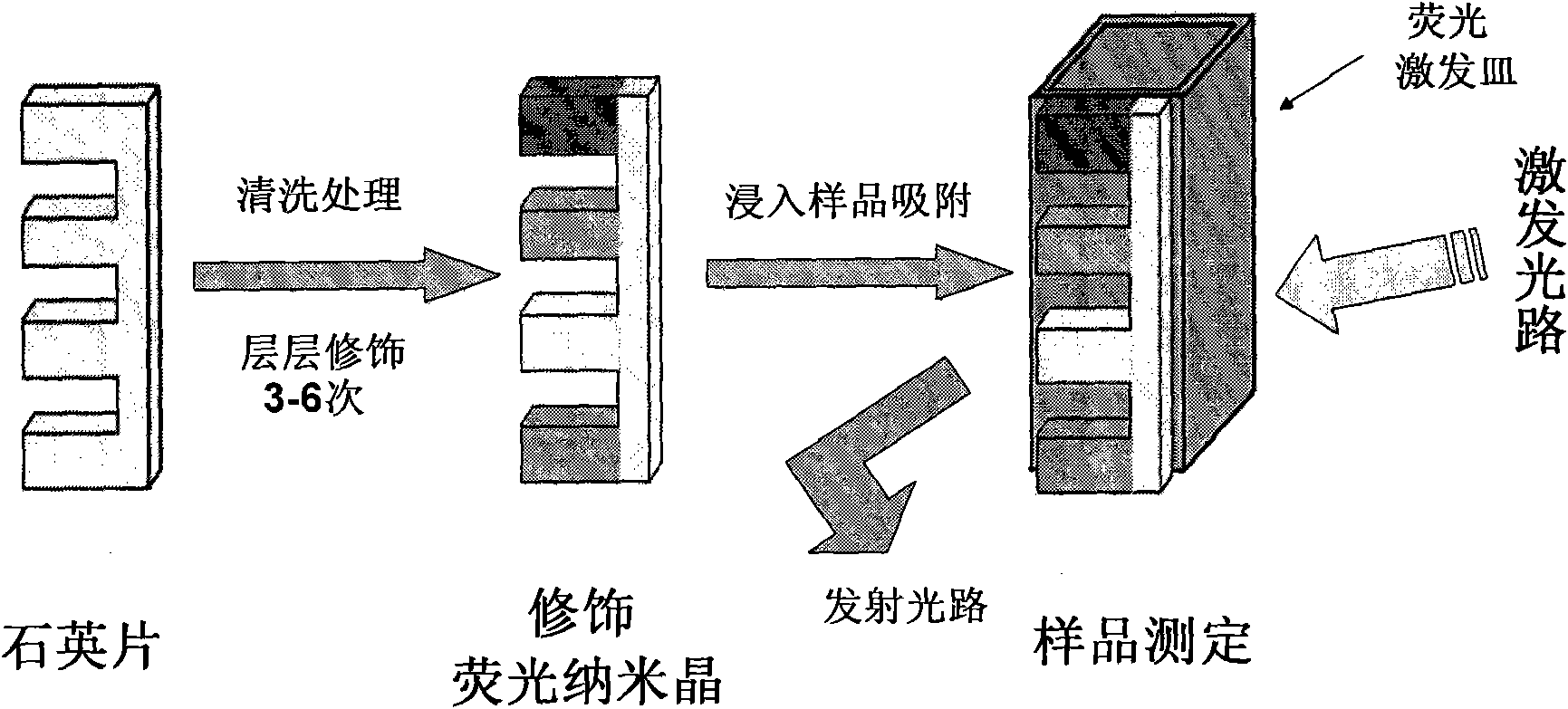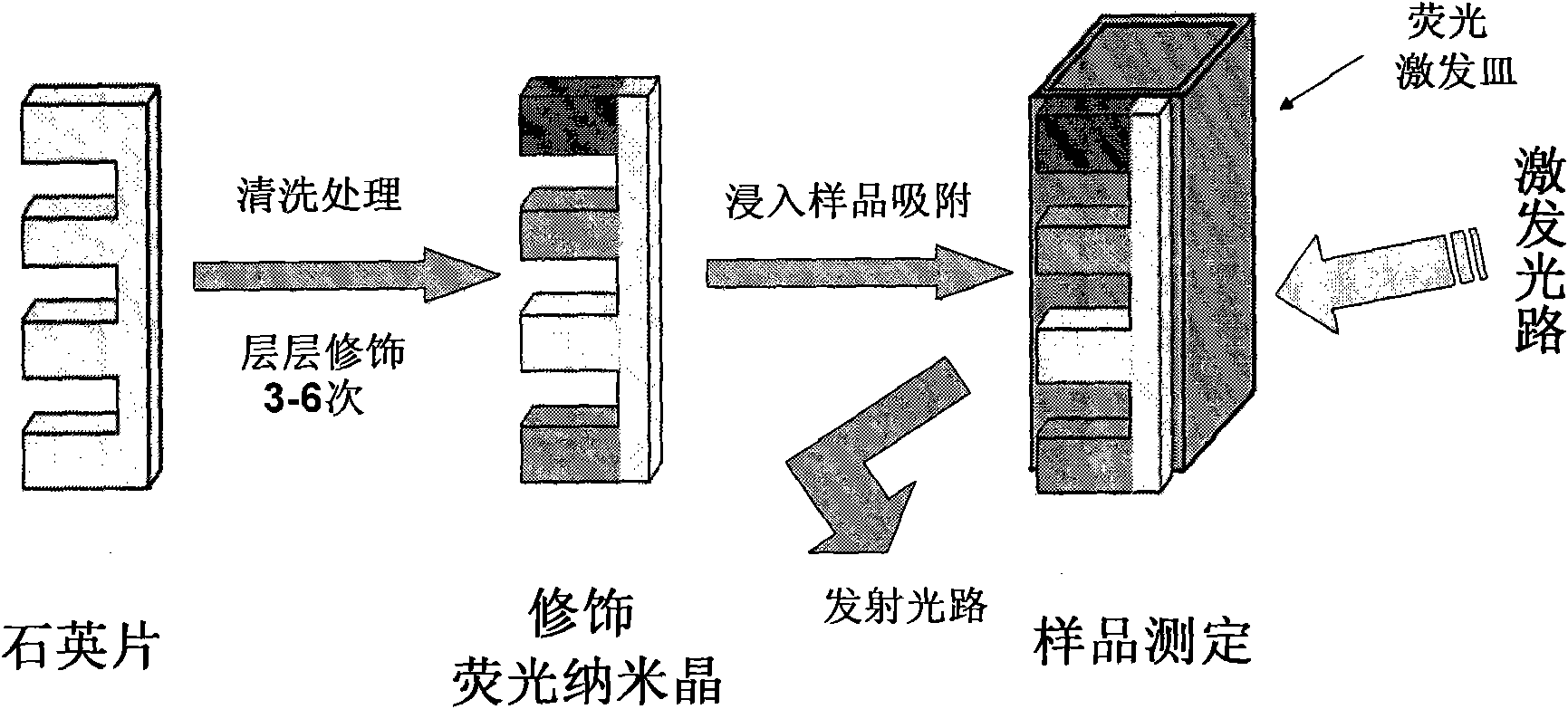Research and application of molecular identification-based fluorescence nanocrystal quartz fluorescent sensor for high-selectivity multicomponent saccharide detection
A fluorescent nanocrystal, fluorescent sensor technology, applied in the directions of fluorescence/phosphorescence, material excitation analysis, etc., can solve the problems of easily causing fractures, complex detection process, high detection cost, and achieve improved accuracy and sensitivity, simple detection steps, and improved The effect of sensitivity
- Summary
- Abstract
- Description
- Claims
- Application Information
AI Technical Summary
Problems solved by technology
Method used
Image
Examples
Embodiment 1
[0050] Example 1 (monosaccharides such as glucose and galactose)
[0051] A preparation method for detecting glucose and lactose molecular recognition fluorescent nanocrystal quartz fluorescent sensor, comprising the following steps:
[0052] (1) Preparation of CdTe fluorescent nanocrystal solutions with different particle sizes: 2 Under protection, the Te powder was dissolved in NaBH 4 Te precursor was prepared in , and then with CdCl 2 2.5H 2 O reacts with the TGA reaction solution, adjusts the pH, and prepares water-soluble CdTe quantum dot solutions of two different particle sizes;
[0053] (2) select the recognition body p-aminophenylboronic acid that can interact with glucose; select the recognition body 3-aminophenylboronic acid that can interact with galactose;
[0054] (3) Take 20 μL of two CdTe fluorescent nanocrystal solutions with different particle sizes, and disperse them by ultrasonic for 20 minutes. Glucose recognition body p-aminophenylboronic acid, catal...
Embodiment 2
[0058] Example 2 (disaccharides such as maltose, sucrose and lactose)
[0059] A preparation method for detecting maltose, sucrose and lactose molecular recognition fluorescent nanocrystal quartz fluorescent sensor, comprising the following steps:
[0060] (1) Preparation of CdSe quantum dot solutions with different particle sizes: in N 2 Under protection, dissolve Se powder in TOP to prepare Se precursor, dissolve S powder in TOP to prepare S precursor, and then combine with the prepared Cd(OA) 2 , reaction, under the condition of oleic acid as a stabilizer, three kinds of CdSe quantum dot solutions with different particle sizes were prepared;
[0061] (2) select the recognition body 3-cyanophenylboronic acid that can interact with maltose; select the recognition body 2-fluorophenylboronic acid that can interact with sucrose; select the identification body 4-ethoxyphenylboronic acid that can interact with lactose;
[0062] (3) Take 20 μL of two CdSe fluorescent nanocrystal ...
Embodiment 3
[0066] Example 3 (polysaccharides such as cellulose, starch and glycogen)
[0067] A preparation method for detecting cellulose, starch and glycogen molecule recognition fluorescent nanocrystal quartz fluorescent sensor, comprising the following steps:
[0068] (1) Preparation of CdTe fluorescent nanocrystal solutions with different particle sizes: 2 Under protection, the Te powder was dissolved in NaBH 4 Te precursor was prepared in , and then with CdCl 2 2.5H 2 O reacts with the TGA reaction solution, adjusts the pH, and prepares water-soluble CdTe quantum dot solutions of two different particle sizes;
[0069] (2) select the recognition body 3-nitrophenylboronic acid that can act with cellulose; select the recognition body 3-methylphenylboronic acid that can act with starch; select the recognition body p-ethylphenylboronic acid that can act with glycogen;
[0070] (3) Take 20 μL of two CdTe fluorescent nanocrystal solutions with different particle sizes, and disperse th...
PUM
 Login to View More
Login to View More Abstract
Description
Claims
Application Information
 Login to View More
Login to View More - R&D
- Intellectual Property
- Life Sciences
- Materials
- Tech Scout
- Unparalleled Data Quality
- Higher Quality Content
- 60% Fewer Hallucinations
Browse by: Latest US Patents, China's latest patents, Technical Efficacy Thesaurus, Application Domain, Technology Topic, Popular Technical Reports.
© 2025 PatSnap. All rights reserved.Legal|Privacy policy|Modern Slavery Act Transparency Statement|Sitemap|About US| Contact US: help@patsnap.com


